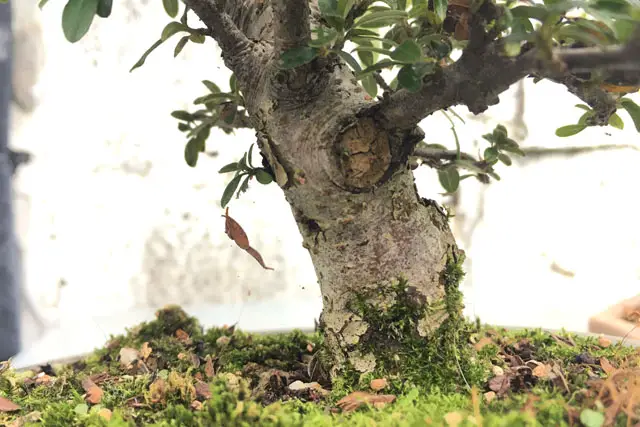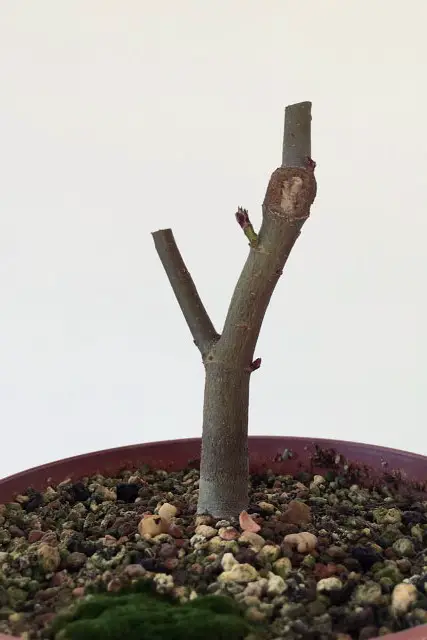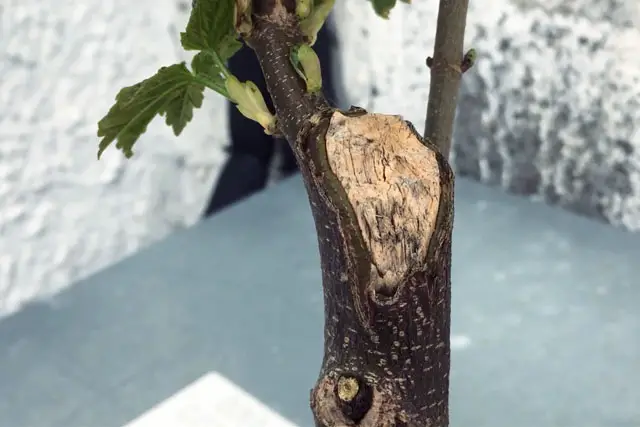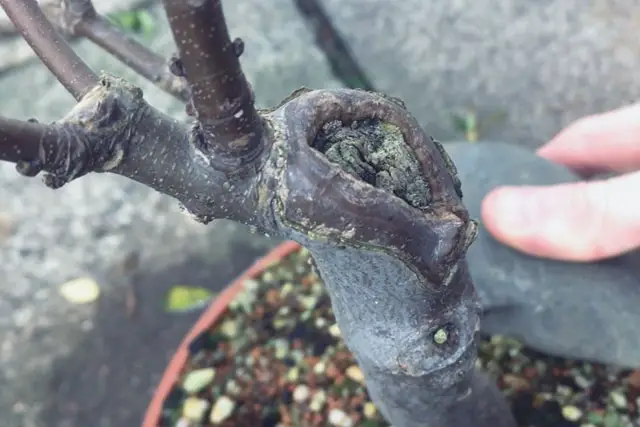When working with bonsai, especially young trees in development you are inevitably going to have to make some large cuts, which will leave you with the problem of large unsightly wounds.
These can sometimes be a disaster and sometimes they can be made into a feature within the tree, allowing it to tell a story about the trees life.

However, a lot of the time we want these wounds to heal over and disappear, nobody wants to be left with ugly scars on their trunk. The best way to heal them is with time and plenty of growth but I will go through some of the techniques that can help heal your wounds.
Page Contents
Healing Wounds On Deciduous Bonsai Trees
A lot of the finesse with deciduous bonsai trees is being able to create a small tree without any scars. This takes a lot of time and effort.
We can all go out to the forest and find a 4 inch diameter trunk, chop it short and take it home and start to develop a new branch structure. The only issue is that it’s always going to have a 4 inch wound that is never going to go away.
Of course we can carve this and make it look interesting and of course we can hide this wound around the back, or behind a foliage pad, but it’s always going to be there.
(Sometimes chopping a trunk like this is a good method to use, you can read more about –Trunk Chopping A Bonsai)
If you are trying to build a more elegant bonsai tree, this approach isn’t going to work. Some of the best Japanese maple bonsai have been grown for decades and do not show any large scars. They will obviously have been pruned, but there are ways to limit wounds and also ways that allow any scars to fully heal and blend in with the surrounding bark.
(You can read more about – Deciduous Bonsai Tree Maintenance)
Healing Wounds On Conifer Bonsai Trees
Conifer bonsai are a totally different game. You can basically avoid scars completely with these trees.
All you need to do is turn any branch you want to remove, into a deadwood feature. This changes what would be a huge wound into something interesting to look at and enjoy.
This can’t always happen, but if you do have to make a wound, the rugged thicker bark of a conifer can make a wound look more interesting and again more of a feature.
(You can read more about – Creating Bonsai Deadwood)
Before Pruning your Bonsai
Before you start making some wounds, you should make sure you have thought about the following things.
What Size Wounds Should You Make On a Bonsai?
Half the battle of stopping scars is to control the size of your wounds. The smaller the wound, the easier and faster it will heal.
However, when you are developing a bonsai tree you need to let it grow out, this will give it thickness, but you also need to then cut it back as you can’t make a bonsai out of a 6ft tall tree.
You need to find the balance of letting it grow, but also cutting it back before it gets too thick. If you wait a number of years you are going to end up with a four inch trunk and then of course a four inch wound.
You are going to get better results by letting your bonsai tree grow out and pruning it back more often. It is going to take you a lot longer to reach the same four inch diameter trunk, but instead of one large cut at the end, you have multiple smaller cuts to get the same result.
The instant reaction is to think more wounds are going to look worse, there will be more scars and it will not be worth the time. While this may be true initially, these smaller wounds are much more likely to fully heal so in the long run you will not be able to see them and it should create the illusion that the tree was never pruned back at all.
I personally do this technique yearly, meaning my wounds are quite small, but it also means that my time spent in development and thickening a bonsai trunk is going to be longer. I can live with this but you will have to find the balance of what works for you.
Make Wounds 2 Inches, Maximum
When you cut branches off your bonsai, you should try and keep your cuts below 2 inches (5cm) in diameter.
Ideally 1-1.5 inch (2.5-3.5cm) or smaller are going to heal the best on a bonsai. If they are just small twigs you are removing, you really don’t need to worry about it.
Once you start making wounds over 2 inches wide your bonsai tree is really going to struggle to heal the wound completely. Bonsai trees are quite small, so wounds this size can be quite significant to them.
The Size and Age Of Your Bonsai Will Determine How Big You Can Make A Wound
The size and age of a Bonsai is going to affect the size of the wound you can make. Making a 1 inch wound may be massive on a little shohin bonsai tree, whereas a wound this size would be nothing on a bigger bonsai tree.
The same goes for a young bonsai tree that is also small. However, the young tree has the advantage that it is going to grow and thicken over time and grow around the wound, making it look smaller over time.

You will probably notice in a lot of my videos that I make some large wounds on my trees and seedlings. At the moment they look like massive wounds, however, the tree is may be pencil thick.
The wounds I have made are not going to get any bigger, but the trunk around them certainly will. In a few years time this type of wound will be tiny in proportion with the thickness of the trunk. I am happy to make big cuts like this on a young tree, as I know they will get swallowed up with future growth.
What If The Wound Is Bigger?
Sometimes you cannot avoid it and you need to make a wound bigger than 2 inches on your tree.
If this happens you will just have to work with what you’ve got and try a different approach such as carving it out to make it a feature rather than trying to get it to close over and heal.
Are Concave or Flat Wounds Better For Bonsai?
The type of wound you create on your bonsai can also play a role in how well it heals.
The theory is that you should make a concave wound. Then when the bonsai starts to callus over, the new tissue will roll into the concave wound and when it meets in the middle, the wound should then be flat, and like nothing was ever removed.
This is 100% true, but everyone forgets to mention that the tree species you do this on comes into play and more importantly the type of bark it has.
If you have a thick barked tree, you want to make a concave wound. The thick bar will roll into the concave wound and basically heal flush.
However, if you have a tree with very thin bark, you actually want to make a flat cut. If you make a concave wound, the bark will enter the wound and heal over, but it will be flush to the contour of the wound, so it will look like the tree has a dent in it. If you imagine pressing your thumb into a ball of playdough, it will be like that.
Knowing what type of bark you have is really going to help you make the right type of wound on your bonsai.
Leaving A Stub For Die Back On A Bonsai
Another very popular method when removing a branch on a bonsai is to leave a little stub. So basically you do not remove the whole branch.
This is of course quite unsightly, but is actually a very good way to reduce damage.
When you make the cut, the remaining section of the branch that you have left will die back, which is fine, but the important thing is what the rest of the tree does. Inside and around the part that dies, the tree will start to form a barrier and compartmentalise the dead area.
The dead section also acts as a barrier, stopping any pathogens that would be able to get into a tree through an open wound.
If you can be patient, you should try the stub cut method. Leave it for a year and then come back to remove it. You can cut back to the live section and leave it to finish healing over.
You will get a better end result, even if it takes slightly longer to fully remove the branch.
After Pruning Your Bonsai
Once you make your wound, you need the tree to start healing as soon as possible.
More Growth Will Heal Wounds
The single best way to heal a wound is to let the tree grow. As the tree grows it is going to keep pushing sap and water up and down the tree, which will cause it to thicken. This is going to allow plenty of energy to be moving past the cut site which will allow for more calluses to form in the area. The quicker callus forms, the quicker the wound will heal over.
If you make any large cuts you have to let the tree grow, it seems counterproductive, but it will get the job done.


The above pictures are from the same tree. The only thing that has happened in between the two picture is a lot of growth. You can see how the new growth has started to grow and callus over and both sides are starting to roll into the centre, where they will hopefully meet and join, healing this wound completely.
Using Wound Sealant On Bonsai
A lot of people like to seal the wound. This can stop moisture leaving the tree, which is a good idea. A tree can become very weak if it loses too much energy. If you cut a tree at the wrong time of year, it can effectively bleed a lot of sap from the wound and potentially kill a tree.
Also, if a wound dries out, it can actually get bigger as it affects the healthy tissue around it and causes this area to dry out and die too.
Sealants can also prevent things getting into the tree, such as pathogens like diseases and fungus.
Bonsai Cut Pastes
These are probably the most common sealants in the bonsai world. It is a putty like paste that you put on the wound and it hardens; you can then scrape it off a few months later when the wound is healing over.
Silver Stickers
These are not that common but I have started seeing these more and more in bonsai.
You can buy silver sticky foil that you can cut to the size you need and put it over the wound. It obviously prevents pathogens getting in, but also apparently helps speed up healing. The foil reflects the sunlight, keeping the area underneath cooler, meaning it dries out less, and therefore heals better.
I have no way to prove this, but those that use it swear it’s very effective.
Wood Glue
A common alternative to cut paste is to use wood glue, or PVA glue. You just smear it on and as it dries it forms a barrier much like the cut paste. This does not harm the tree any way and is easy to remove at a later date by just peeling it away.
Natural/Leave Alone
You then have people (myself included) who just leave the wounds to fend for themselves. The thinking is that a tree can look after its self. In nature if it loses a branch it doesn’t need a sealant, it just sorts itself out. This is true, as I’ve discussed above a tree can compartmentalise a damaged area, which it will do when we prune it.
All the wounds I make are quite small, so I am happy for the tree to deal with it naturally, if I was making some very large cuts I may use some form of sealant.
Re-Opening Old Wounds On A Bonsai
A very useful technique is to reopen the wound to force it to keep sealing over. When a tree calluses over it usually starts to roll into the wound, but after a while it will stop.
This can leave that classic little round hollow you always see on trees in nature. You can go around the inner edge of the new callas and re-open the wound. This is going to force the tree to send more tissue to this area to reseal the new wound, which in turn, makes it close further and hopefully meet in the middle where it will then be fully healed.
You can do this technique every few months during the growing season. Just keep your eye on the wound and if you think its healing is slowing down, re-open it to get it going again.
Conclusion
If you manage your trees growth properly you should not be removing branches that are going to leave huge wounds. However, if you do need to remove larger branches you can now make sure you plan your cuts properly and give your tree the right aftercare and most importantly, you now know that you need to let the tree grow to recover.

Hi, I’m Ian. I have been doing bonsai since 2014. I created this site to spread all the knowledge I have acquired over the years. Don’t forget to check out my Youtube videos where I show the progress of my own Bonsai each week or connect with me on social media.
You can read more about me and how I got into Bonsai on the About Page


